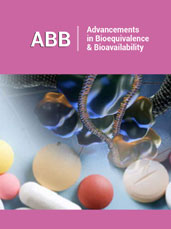- Submissions

Full Text
Advancements in Bioequivalence & Bioavailability
Classical Drug Serratia Marcescens L-Asparaginase and Anticancer Activity In Vitro
Rahul Hajare*
Post Doc Scholar, Indian Council of Medical Research New Delhi, India
*Corresponding author:Rahul Hajare, Post Doc Scholar, Indian Council of Medical Research, New Delhi, India
Submission: September 23, 2018;Published: September 26, 2018

ISSN 2640-9275 Volume1 Issue5
Introduction
The present study aimed to production of L-asparaginase from spiny cactus peel waste extract (SCPWE) by submerged cultures of Serratia marcescens. S. marcescens grew well for 180h in SCPWE containing medium, revealed the presence of enough carbohydrate source for growing S. marcescens and production of Asparaginase. Different parameters, such as pH [1,2], temperature and incubation period, were optimized for growth and maximum L-asparaginase production. The optimum culture parameters were 30ì 60h and pH 8.6. Maximum L-asparaginase and biomass were observed at the end of the logarithmic phase (6.4 IU/ml and 2.96g%, respectively). L-asparaginase activity and biomass were increased from 1.4IU/ml and 0.56g% to 6.4 IU/ml and 2.96 g% respectively at the end of logarithmic phase (60h). Higher yields of L-asparaginase (6.4IU/ml) with a specific activity of 1984IU/ml (89-fold purification with 39 % recovery) were obtained from S. marcescens cultures. The purified L-asparaginase was used for the characterization and general properties were used such as effect of pH and temperature as well as stability at pH and temperature on L-asparaginase activity.
The optimum pH 8.6 and 50ꃠtemperature on L asparaginase showed 100% residual activity. Stability of pH around 8.6 and temperature 70 ꃠshowed 90 and 78 % residual activity at 30 and 60 min respectively. The L-asparaginase showed high stability at alkaline pH (pH8.6) when incubated for up to 60h.The molecular weight of the produced L-asparaginase was close to 160kKm and Vmax of the purified L-asparaginase were found to be 6.72mM and 0.16 卬 respectively [3,4]. Cytotoxic activity of L asparaginase was examined in vitro using four carcinoma cell lines. Asparaginase has higher effective in growth inhibition against HEPG2 and HCT- 116 but lower against HELLA and MCF7 carcinoma cell lines. The data show that asparaginase has a higher cytotoxic activity against HEPG2 and HCT116, revealed higher percentage of cell death, indicating antitumor properties, and demonstrate direct effect on cancer cell proliferation of HEPG2 and HCT116. Therefore, SCPWE was considered to be a suitable carbohydrate source for growing S. marcescens and production of L-asparaginase has higher activity and good stability. Purified L-asparaginase [5] obtained from S. marcescens could be employed in drug chemotherapy and treatment of cancer.
Acknowledgement
This study has been guided under the supervision and guidance of Renowned Immunologist Respected Dr. Ramesh S. Paranjape, Long-Time NARI Director, India.
References
- Paranjape Ramesh, Hajare Rahul (2018) Correction: Generation and characterization of new entrance antiretroviral Drug 2-indolinone: results of a classical r&d study. Organic & Medicinal Chem IJ 6(2): 555685.
- Rahul Hajare, (2018) Classical R&D and laboratory practises of 8-methoxy-5-(morpholin-4-ylmethyl)-4,4a,5,9b-tetrahydro-1hpyrazino[ 2,3-b] indole-2,3-dicarbonitrile. Journal to Chemistry Journal 1(1): 40-44.
- Rahul Hajare (2018) A Phase I drug discovery and one-, two-, and threeclass of indoline-2,3-dione testing for Anticancer and cytotoxic activity. Organic & Medicinal Chem IJ 6(2): 555682.
- Rahul Hajare, Subhas Kark (2016) Characterization of novel 2-indolinone derivatives as anticancer and cytotoxic activity. World J Pharm Pharm Sci 5(1): 995-1002.
- Rahul Hajare (2018) Increasing trend of classical r & d and laboratory practises of 8-methoxy-5-(morpholin-4-ylmethyl)-4, 4a, 5, 9b-tetrahydro-1h-pyrazino [2,3-b] indole-2, 3-dicarbonitrile. SF Drug Deliv Res 1(1):1.
© 2018 Rahul Hajare. This is an open access article distributed under the terms of the Creative Commons Attribution License , which permits unrestricted use, distribution, and build upon your work non-commercially.
 a Creative Commons Attribution 4.0 International License. Based on a work at www.crimsonpublishers.com.
Best viewed in
a Creative Commons Attribution 4.0 International License. Based on a work at www.crimsonpublishers.com.
Best viewed in 







.jpg)






























 Editorial Board Registrations
Editorial Board Registrations Submit your Article
Submit your Article Refer a Friend
Refer a Friend Advertise With Us
Advertise With Us
.jpg)






.jpg)














.bmp)
.jpg)
.png)
.jpg)










.jpg)






.png)

.png)



.png)






